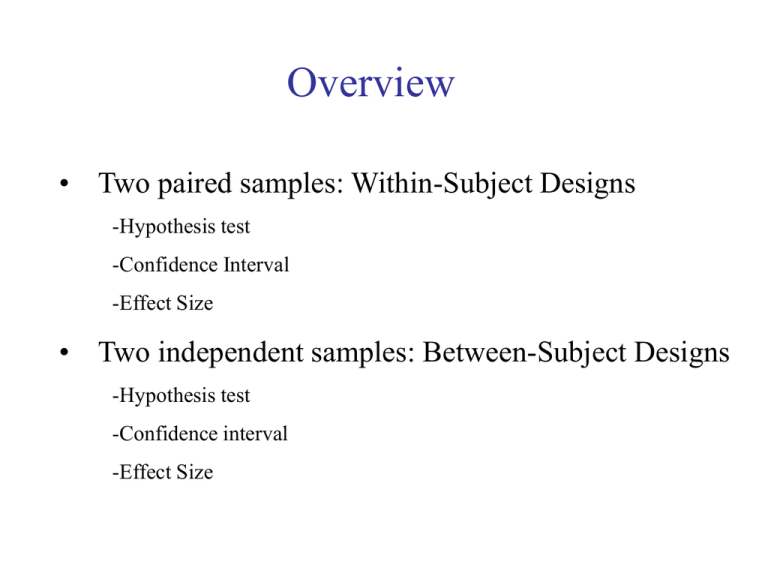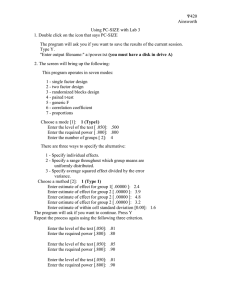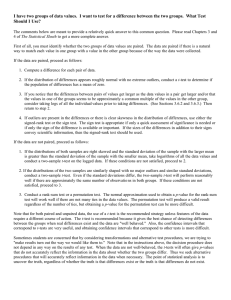Overview • Two paired samples: Within-Subject Designs -Hypothesis test
advertisement

Overview • Two paired samples: Within-Subject Designs -Hypothesis test -Confidence Interval -Effect Size • Two independent samples: Between-Subject Designs -Hypothesis test -Confidence interval -Effect Size Comparing Two Populations Until this point, all the inferential statistics we have considered involve using one sample as the basis for drawing conclusion about one population. Although these single sample techniques are used occasionally in real research, most research studies aim to compare of two (or more) sets of data in order to make inferences about the differences between two (or more) populations. What do we do when our research question concerns a mean difference between two sets of data? Two kinds of studies There are two general research strategies that can be used to obtain the two sets of data to be compared: 1. The two sets of data could come from two independent populations (e.g. women and men, or students from <- between-subjects design section A and from section B) 2. The two sets of data could come from related populations (e.g. “before treatment” and “after treatment”) <- within-subjects design Part I • Two paired samples: Within-Subject Designs -Hypothesis test -Confidence Interval -Effect Size Paired T-Test for Within-Subjects Designs Our hypotheses: Ho: D = 0 HA: D 0 To test the null hypothesis, we’ll again compute a t statistic and look it up in the t table. Paired Samples t t = D - D sD s sD = n Steps for Calculating a Test Statistic Paired Samples T 1. Calculate difference scores 2. Calculate D 3. Calculate sd 4. Calculate T and d.f. 5. Use Table E.6 Confidence Intervals for Paired Samples General formula X t (SE) Paired Samples t D t (sD) Effect Size for Dependent Samples One Sample d X H0 ˆ d s Paired Samples d D ˆ d sD Exercise In Everitt’s study (1994), 17 girls being treated for anorexia were weighed before and after treatment. Difference scores were calculated for each participant. Change in Weight n = 17 D = 7.26 sD = 7.16 Test the null hypothesis that there was no change in weight. Compute a 95% confidence interval for the mean difference. Calculate the effect size Change in Weight n = 17 D = 7.26 sD = 7.16 T-test Exercise SE 7.16 1.74 17 7.26 0 t (16) 4.17 1.74 p .01 Change in Weight n = 17 D = 7.26 sD = 7.16 Confidence Interval Exercise tcrit 2.12 CI 7.26 2.12(1.74) (3.57,10.95) Change in Weight n = 17 D = 7.26 sD = 7.16 Exercise Effect Size 7.26 d 7.16 d 1.01 Part II • Two independent samples: Between-Subject Designs -Hypothesis test -Confidence Interval -Effect Size T-Test for Independent Samples The goal of a between-subjects research study is to evaluate the mean difference between two populations (or between two treatment conditions). We can’t compute difference scores, so … Ho: 1 = 2 HA: 1 2 T-Test for Independent Samples We can re-write these hypotheses as follows: Ho: 1 - 2 = 0 HA: 1 - 2 0 To test the null hypothesis, we’ll again compute a t statistic and look it up in the t table. T-Test for Independent Samples General t formula t = sample statistic - hypothesized population parameter estimated standard error One Sample t ttest X H0 sX Independent samples t t ( X 1 X 2 ) ( 1 2 ) s X1 X 2 s X1 X 2 ? T-Test for Independent Samples Standard Error for a Difference in Means s X1 X 2 The single-sample standard error ( sx ) measures how much error expected between X and . The independent-samples standard error (sx1-x2) measures how much error is expected when you are using a sample mean difference (X1 – X2) to represent a population mean difference. T-Test for Independent Samples Standard Error for a Difference in Means s X1 X 2 s12 s22 n1 n2 Each of the two sample means represents its own population mean, but in each case there is some error. The amount of error associated with each sample mean can be measured by computing the standard errors. To calculate the total amount of error involved in using two sample means to approximate two population means, we will find the error from each sample separately and then add the two errors together. T-Test for Independent Samples Standard Error for a Difference in Means s X1 X 2 s12 s22 n1 n2 But… This formula only works when n1 = n2. When the two samples are different sizes, this formula is biased. This comes from the fact that the formula above treats the two sample variances equally. But we know that the statistics obtained from large samples are better estimates, so we need to give larger sample more weight in our estimated standard error. T-Test for Independent Samples Standard Error for a Difference in Means s X1 X 2 s 2 p n1 s 2 p n2 We are going to change the formula slightly so that we use the pooled sample variance instead of the individual sample variances. This pooled variance is going to be a weighted estimate of the variance derived from the two samples. SS1 SS2 s df1 df 2 2 p Steps for Calculating a Test Statistic One-Sample T 1. Calculate sample mean 2. Calculate standard error 3. Calculate T and d.f. 4. Use Table D Steps for Calculating a Test Statistic Independent Samples T 1. Calculate X1-X2 2 p 2 p s s n1 n2 2. Calculate pooled variance s2p SS1 SS2 df1 df 2 3. Calculate standard error 4. Calculate T and d.f. 5. Use Table E.6 t (X1 X 2 ) (1 2 ) sx1 x2 d.f. = (n1 - 1) + (n2 - 1) Illustration A developmental psychologist would like to examine the difference in verbal skills for 8-year-old boys versus 8year-old girls. A sample of 10 boys and 10 girls is obtained, and each child is given a standardized verbal abilities test. The data for this experiment are as follows: Girls n1 = 10 X1 = 37 SS1 = 150 Boys n2 = 10 X 2 = 31 SS2 = 210 Girls n1 = 10 X1 = 37 SS1 = 150 Boys Illustration n2 = 10 X 2 = 31 SS2 = 210 STEP 1: get mean difference X1 X 2 6 Boys Girls n1 = 10 X1 = 37 SS1 = 150 Illustration n2 = 10 X 2 = 31 SS2 = 210 STEP 2: Compute Pooled Variance SS1 SS2 150 210 360 s 20 df1 df 2 (10 1) (10 1) 18 2 p Boys Girls n1 = 10 X1 = 37 SS1 = 150 Illustration n2 = 10 X 2 = 31 SS2 = 210 STEP 3: Compute Standard Error s2p s2p 20 20 SE 4 2 n1 n2 10 10 Boys Girls n1 = 10 X1 = 37 SS1 = 150 Illustration n2 = 10 X 2 = 31 SS2 = 210 STEP 4: Compute T statistic and df (X1 X 2 ) (1 2 ) (37 31) 0 t 3 sx1 x2 2 d.f. = (n1 - 1) + (n2 - 1) = (10-1) + (10-1) = 18 Girls n1 = 10 X1 = 37 SS1 = 150 Boys Illustration n2 = 10 X 2 = 31 SS2 = 210 STEP 5: Use table E.6 T = 3 with 18 degrees of freedom For alpha = .01, critical value of t is 2.878 Our T is more extreme, so we reject the null There is a significant difference between boys and girls T-Test for Independent Samples Sample Hypothesized Population Data Parameter Single sample t-statistic X Independent X1 X 2 samples t-statistic 1 2 Sample Variance SS s df 2 SS SS2 s 1 df1 df 2 2 p Estimated Standard Error t-statistic X t sx s2 n s2p s2p n1 n2 t (X1 X 2 ) (1 2 ) sx1 x2 Confidence Intervals for Independent Samples General formula X t (SE) One Sample t X t (sx) Independent Sample t (X1-X2) t (sx1-x2) Effect Size for Independent Samples One Sample d X H0 ˆ d s Independent Samples d X1 X 2 ˆ d sp Exercise Subjects are asked to memorize 40 noun pairs. Ten subjects are given a heuristic to help them memorize the list, the remaining ten subjects serve as the control and are given no help. The ten experimental subjects have a X-bar = 21 and a SS = 100. The ten control subjects have a X-bar = 19 and a SS = 120. Test the hypothesis that the experimental group differs from the control group. Give a 95% confidence interval for the difference between groups Give the effect size Experimental Control n1 = 10 X1 = 21 SS1 = 100 Exercise n2 = 10 X 2 = 19 SS2 = 120 T-test X1 X 2 2 SS1 SS 2 100 120 220 s 12.2 df1 df 2 (10 1) (10 1) 18 2 p SE s 2p n1 s 2p n2 12.2 12.2 2.44 1.56 10 10 Experimental n1 = 10 X1 = 21 SS1 = 100 T-test Control Exercise n2 = 10 X 2 = 19 SS2 = 120 ( X 1 X 2 ) ( 1 2 ) 2 0 t 1.28 s x1 x2 1.56 d.f. = (n1 - 1) + (n2 - 1) = (10-1) + (10-1) = 18 p .20 Experimental n1 = 10 X1 = 21 SS1 = 100 Confidence Interval Control Exercise n2 = 10 X 2 = 19 SS2 = 120 tcrit 2.101 CI 2 2.101(1.56) (1.28,5.28) Experimental n1 = 10 X1 = 21 SS1 = 100 Effect Size Control Exercise n2 = 10 X 2 = 19 SS2 = 120 X1 X 2 d sp 2 d 12.2 d .57 Summary Hypothesis Tests 1 Sample Confidence Intervals 2 Paired Samples Effect Sizes 2 Independent Samples Review Sample Hypothesized Population Data Sample Variance Parameter One sample t-statistic Paired samples tstatistic X D Independent samples X1 X 2 t-statistic Estimated Standard Error SS s df s2 n D SS s D df s2 n 1 2 2 2 SS SS2 s 1 df1 df 2 2 p t-statistic t X sx D D t sD s2p s2p n1 n2 t (X1 X 2 ) (1 2 ) sx1 x2 Confidence Intervals One Sample t X t (SE) Paired Samples t D t (sD) Independent Sample t (X1-X2) t (sx1-x2) Effect Sizes One Sample d X H0 ˆ d s Paired Samples d D ˆ d sD Independent Samples d X1 X 2 ˆ d sp







